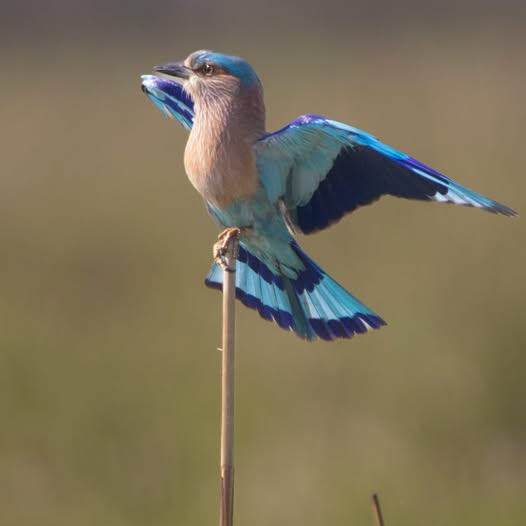10 interesting facts about the Neelkanth bird– And why spotting it on Dussehra is considered auspicious
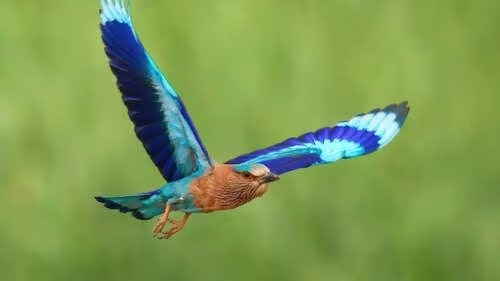
10 interesting facts about the Neelkanth bird– And why spotting it on Dussehra is considered auspicious
Neelkanth is a bird commonly known as the Indian Roller. It is admired for its cultural significance and striking blue plumage. It is often seen as a symbol of good fortune. Beyond this, this bird also plays an important ecological role in ecosystems and agriculture.
Here are some interesting facts about this beautiful bird, which is considered auspicious in Hindu culture.
211
The myth behind the name Neelkanth
Though the name “Neelkanth” literally means “blue throat,” the Indian Roller does not have a distinctly blue throat in reality. The name is symbolic and often linked to Lord Shiva’s blue throat. The bird instead has striking turquoise and indigo wing feathers. Its name shows how culture and mythology strongly influence naming.
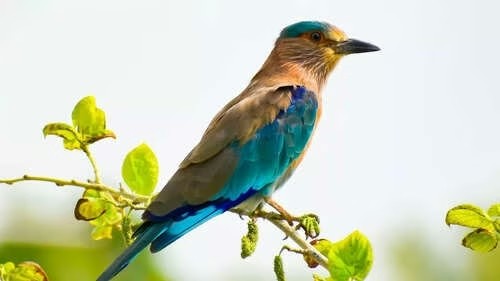
Why spotting Neelkanth bird on Dussehra is considered auspicious
In Hindu tradition, seeing the Neelkanth on Dussehra (Vijayadashami) is considered auspicious. According to legends, Lord Rama saw a Neelkanth before heading to Lanka, and some link the bird to Lord Shiva’s blue throat. This belief drives large gatherings to spot it during festivals. It reflects deep cultural reverence for nature.
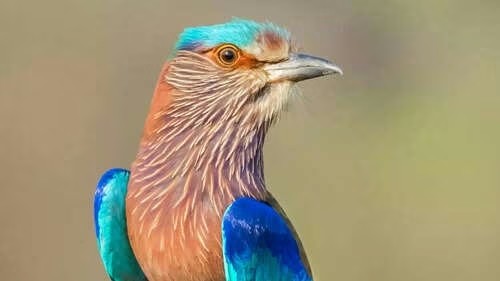
Aerobatic flight displays by males
During the breeding season, male Indian Rollers perform spectacular aerial displays – twisting, rolling, and diving midair – to attract mates and defend territory. They produce croaking calls while flying, adding drama to their show. The sight often earns them admiration in rural India.
511
Wide geographic distribution
The Indian Roller ranges from West Asia through the Indian subcontinent to parts of Southeast Asia, adapting to various habitats such as open grasslands, scrub forests, and human-modified landscapes. They thrive in dry regions as well as near cultivated fields. Their adaptability ensures their continued survival across borders.
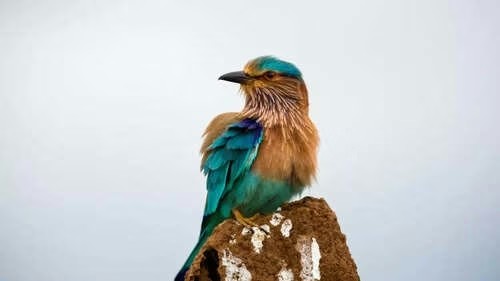
Habitat and perch behaviour
It often perches conspicuously on trees, wires, poles, or open bare perches – so it can spot ground insects and swoop down. Farmers value it for reducing crop pests. Because it prefers open spaces, it is one of the most visible birds in rural and semi-urban India.
711
Diet and hunting method
The Neelkanth mostly feeds on insects (especially beetles), but also catches spiders, small reptiles, amphibians, and grasshoppers. It often follows tractors or wildfires to catch insects flushed out of the ground. Its feeding style is opportunistic, showing intelligence in using human and natural disturbances.

Nesting in cavities or crevices
They nest in tree hollows, rock crevices, or sometimes in human structures. The nest is minimally lined (wood debris or feathers), and females typically lay 3 to 5 eggs. Both parents share incubation duties. Their nesting habits highlight their ability to coexist in human-dominated landscapes.

State bird and cultural symbol
The Indian Roller (Neelkanth) is the state bird of several Indian states, including Odisha, Karnataka, and Telangana. Its vivid blue plumage and cultural symbolism make it a national pride.
1011
Threat from superstitions
Due to its believed auspiciousness, Neelkanths are often poached and confined in the course of festivals. They endanger the species with their wings or legs being destroyed so that they cannot flee. Such activities not only hurt the bird but also disrupt the ecology. This practice is inhuman and has been a major battle for conservationists.
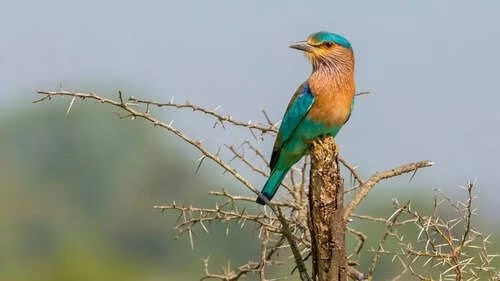
Strong conservation position.
The wide distribution of the species and stable population make the IUCN (International Union for Conservation of Nature) perform the classification of this species as the Least Concern, although local declines are possible due to habitat destruction and persecution. It is sturdy because it is able to fit into farmlands and open countryside. Nevertheless, surveillance is necessary to avoid threats in the future.
The Neelkanth, or Indian Roller (Coracias benghalensis), is revered in India for its brilliant blue plumage and deep connection to Hindu mythology. Observing this bird on Dussehra is considered highly auspicious, believed to bring good fortune and the blessing of deities.
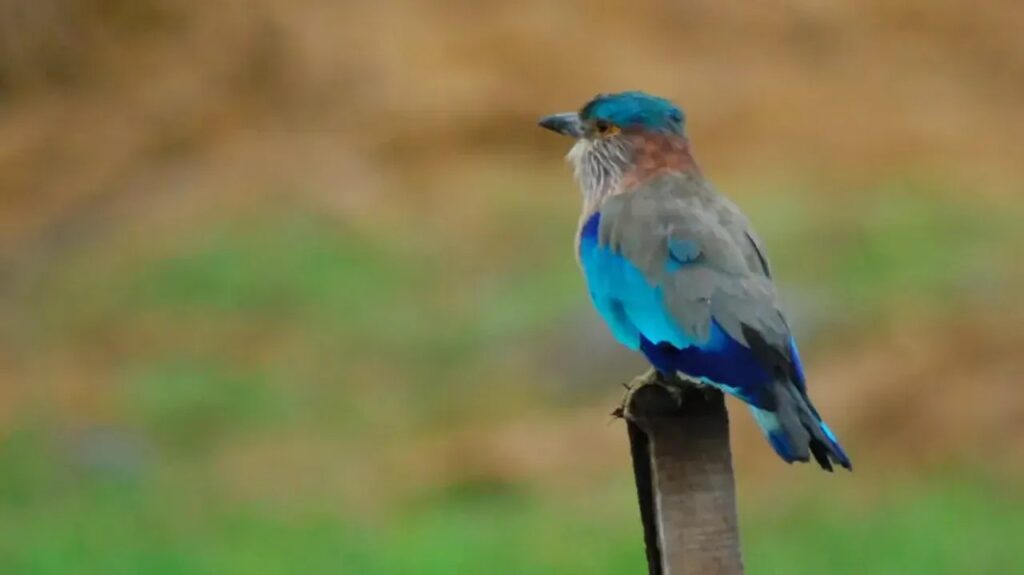
Neelkanth, the state bird of Odisha: Know its cultural and spiritual significance
The Indian Roller, commonly known as Neelkanth, is more than just a bird; flying high as a symbol of divinity, fortune, and heritage. With its mesmerizing blue plumage and deep-rooted connection to Hindu mythology, the Neelkanth enjoys a special place in Indian culture, especially in Odisha, where it is honoured as the state bird.
Every year, as Dussehra approaches, the reverence for this magnificent bird grows. Many believe that catching a glimpse of the Neelkanth on this auspicious day can bring immense prosperity and remove obstacles from one’s life.
But why does this bird command such deep respect? Let’s explore its cultural, spiritual, and ecological significance:
The Neelkanth – Odisha’s Pride and Natural Treasure
The Neelkanth (Coracias benghalensis), often referred to as the Indian Roller, is admired for its striking hues of blue and green.
Native to the Indian subcontinent, it thrives in open fields, light forests, and agricultural lands. The bird’s beauty is so captivating that it has been featured in Indian folklore, poetry, and even state emblems.
In Odisha, the Neelkanth represents more than just biodiversity—it symbolizes prosperity and harmony. Farmers, in particular, consider the sighting of the bird a positive omen, believing it foretells a bountiful harvest.
ALSO READ: Not Bhubaneswar but this southern district has the largest railway station in Odisha; know details
Mythological and Spiritual Importance
The reverence for the Neelkanth extends deep into Hindu mythology. The name ‘Neelkanth’ translates to ‘blue throat’ and is often associated with Lord Shiva, who consumed poison during the churning of the ocean (Samudra Manthan), saving the universe from destruction.
Additionally, the bird is connected to Lord Rama’s epic battle in the Ramayana. Before setting out to defeat Ravana, Lord Rama is said to have spotted a Neelkanth, interpreting it as a divine sign of victory. This belief has given rise to the tradition of watching the bird on Dussehra, with devotees hoping for similar divine blessings in their lives.
ALSO READ: Redefining agriculture: Odisha farmers harvest success with marigold cultivation
The Neelkanth and Dussehra: A Symbol of Triumph
Dussehra, also known as Vijayadashami, is celebrated across India to mark the victory of good over evil—whether it be Lord Rama’s conquest over Ravana or Goddess Durga’s triumph over Mahishasura.
In Odisha, the festival’s rituals include a unique tradition—spotting the Neelkanth. It is believed that setting eyes on this bird on Dussehra can wash away sins and attract good fortune. Devotees often search for the bird in open landscapes, offering prayers as they gaze upon its vibrant form soaring across the sky.
In Odisha, its status as the state bird is a matter of pride, intertwining nature with tradition. Further, by fostering awareness and respect for the Neelkanth, we can ensure that its blue wings continue to grace Odia skies for generations to come.
10 interesting facts about the Neelkanth bird
- Named for Lord Shiva: The bird’s name, “Neelkanth,” translates to “blue throat,” referencing the Hindu deity Lord Shiva. According to legend, Shiva’s throat turned blue after he drank a toxic poison during the churning of the cosmic ocean, an act that saved the universe.
- Acrobatic courtship: The “roller” part of its English name comes from the males’ spectacular aerial courtship displays. During the breeding season, they perform twisting, rolling, and diving flights to attract a mate.
- Feather color is structural, not pigmented: The brilliant blue color of the Neelkanth’s feathers is not due to a pigment. Instead, it is a structural color, caused by the way light scatters off of microstructures within the feather barbs.
- Important for farmers: The Neelkanth is often called the “friend of farmers” because it feeds on insects like beetles, grasshoppers, and termites, which are common crop pests. It will also follow farm equipment to catch invertebrates disturbed by the machinery.
- Perching predator: A “wait and watch” hunter, the Neelkanth sits motionless on a high perch—such as trees, wires, or poles—to scan for ground insects and small animals. Once it spots prey, it swoops down to catch it.
- State bird of three Indian states: The Indian Roller is the state bird of Odisha, Karnataka, and Telangana.
- Adaptive and widespread: This species is found across a broad range in tropical Asia, from Iraq through the Indian subcontinent to Southeast Asia. It thrives in diverse habitats, including open grasslands, scrub forests, and human-modified areas like parks.
- Feeds near fires: The Neelkanth is known to be attracted to wildfires, where it hunts for insects flushed out by the smoke.
- Nesting in cavities: Neelkanths are cavity nesters, making their homes in tree hollows, rock crevices, or even man-made structures. Both the male and female birds share incubation duties for the 3 to 5 eggs.
- Distinct appearance: Although its name implies a blue throat, the bird’s throat is actually a dull reddish-brown. The most striking colors—vivid turquoise, purple, and blue—are primarily visible on its wings and tail when in flight.
Indian Roller

Scientific Name: Coracias benghalensis Common Name: Indian Roller, Blue Jay Other Names: Neelkanth, Jaybird, Rollier indien
Identifying Features: blue-green wings, brown belly, blue crown, black bill
Fun Facts:
- Indian Roller got its name as roller due to the aerobatics they use to display in a series of rolling motion as an act of courtship.
- They use to sit motionless on high standpoints for the purpose of hunting. This helps them to scan the field for prey items.
Why spotting a Neelkanth on Dussehra is considered auspicious
Spotting a Neelkanth on the Hindu festival of Dussehra (also called Vijayadashami) is considered auspicious due to several intertwined mythological and symbolic beliefs.

Why is it considered auspicious to see the Neelkanth bird
Oct 1, 2025, 10:00
Why is it considered auspicious to see the Neelkanth bird on Dussehra
Dussehra, a major festival in India, is the celebration of good over evil, light prevailing over darkness, and truth over injustice. Although the festival is most famous for burning Ravana’s effigies and a recitation of Lord Rama’s tale of victory, a lot of subtle practices are incorporated into its observance. One of them is the practice that seeing the Neelkanth bird (known as the Indian roller) on Dussehra would result in lot of good luck and blessings from god.
Mythological connections:
- A sign for Lord Rama: One legend states that before going to war with the demon king Ravana, Lord Rama spotted a Neelkanth bird, taking its appearance as a divine blessing and an omen of his eventual victory. After killing Ravana, Lord Rama is said to have seen the bird again, with Lord Shiva appearing in the form of the Neelkanth to absolve him of the sin of killing a Brahmin.
- Lord Shiva’s messenger: The Neelkanth is believed to be Lord Shiva’s messenger, or even his living embodiment, because of the name they share. On Dussehra, a festival celebrating the triumph of good over evil, the bird is thought to carry the blessings and protection of Shiva.
Mumbai: This year, Dussehra will be celebrated on October 2, 2025. On this day, spotting the Neelkanth bird (Indian roller) is believed to bring immense good fortune.
Many devotees keep their eyes on the sky from early morning, waiting to catch a glimpse of this sacred bird. But do you know why it is considered so important to see the Neelkanth on Dussehra? Let’s find out.Significance of Seeing Neelkanth on Dussehra
On Dussehra, the sight of the Neelkanth bird is regarded as extremely lucky. It is associated with Lord Rama’s victory over Ravana and symbolizes prosperity, peace, and success. It is said that those who witness the bird on this day are blessed with auspicious beginnings and achievements throughout the year.Mythological Connection with Lord Rama
According to legend, before and after killing Ravana, Lord Rama saw the Neelkanth bird, which became a sign of triumph. After Ravana’s death, Rama was burdened with the sin of killing a Brahmin (since Ravana was a Brahmin by birth). Pleased with Rama’s devotion, Lord Shiva appeared in the form of the Neelkanth bird and absolved him of the sin. Hence, spotting this bird on Dussehra is considered a symbol of divine victory and blessings.
Neelkanth as a Symbol of Positive Energy
In Hinduism, the Neelkanth bird is believed to radiate positive energy. Its presence removes negativity and opens the path for good luck. Seeing the bird on Dussehra is said to bring prosperity, happiness, and long-lasting success into one’s life.Beliefs Related to Marriage and Victory
There is also a belief that unmarried individuals who see the Neelkanth bird on Dussehra will soon find suitable life partners, as obstacles in marriage get removed. Along with this, if the Neelkanth is seen near a Shami tree, it is regarded as a powerful omen of victory over enemies and success in battles of life.
In essence, Neelkanth Darshan on Dussehra is not just a ritual but a spiritual belief that connects divine blessings with nature. It is seen as a reminder that victory, prosperity, and peace come when the divine and the natural world are in harmony.
Symbolism and tradition:
- Victory and new beginnings: As Dussehra marks the triumph of good over evil, seeing the Neelkanth is viewed as a sign that one’s personal struggles will also end in success. The bird’s appearance in the autumn season, after the rains, also symbolizes new beginnings and hope.
- Removal of sins and obstacles: The Neelkanth is believed to radiate positive energy that can remove negativity and obstacles. Some traditions say that observing the bird on Vijayadashami can cleanse a person of their sins and bring good fortune.
- Prosperity and good luck: The sighting of this beautiful bird is thought to bring prosperity and good luck to the observer for the coming year. In agrarian communities, seeing the Neelkanth is considered a good omen for a bountiful harvest.
Spotting a Neelkanth bird on Dussehra is believed to bring good luck and prosperity. It is considered a divine blessing, signifying that the observer will overcome obstacles and achieve success in their endeavours. People often make a wish or offer prayers when they witness this bird on this auspicious day. Shot at #Katarniyaghat wild life sanctuary.
